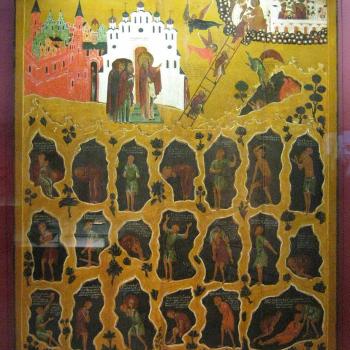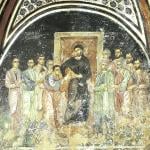“Therefore I tell you, the kingdom of God will be taken away from you and given to a people that produces the fruits of the kingdom. The one who falls on this stone will be broken to pieces; and it will crush on anyone whom it falls” (Matthew 22:42 – 44).
Reading these verses with Yogācārin eyes, we note several distinctive features. Jesus identifies himself with a stone that will break into pieces those who fall upon it, that is, he will break apart those who turn to him for salvation. Their egos, their sense of self, will be shattered. What remains are only the pieces which no longer combine to form one individual. This shows us that what seemed to be one was really many different things. They were not necessarily united to each other, but only came together contingently. We are also told that the kingdom of heaven is given to those who “produce the fruits of the kingdom.” What is this fruit of the kingdom Jesus is talking about? It is the seed of enlightenment, the seed of salvation which overturn and destroy the defilements left within our consciousness.
A Christian who comes to Jesus, who puts their faith in Jesus, reaches out of the shell of the self, and slowly lets the shell be broken up into pieces by Jesus so that they experience reality, not only through their own consciousness, but in Christ by joining in with his life and death. They find Jesus within themselves, and in doing so, they find they are no longer themselves. The more they engage in Jesus, the more they share in the life and activity of Jesus, leading to Jesus opening them up and revealing more of what is real once the veil which covers the suchness of reality is removed.
Thich Nhat Hanh tells us that the invocation of the name of the Buddha is used to bring the Buddha’s reality, which already exists within the individual, out into the open. “When we invoke the Buddha’s name, we evoke the same Buddha-qualities in ourselves. We practice in order to make the Buddha come alive within us, so that we can be released from afflictions and attachments.”[1] Invoking Jesus in faith is to bring our own awareness to the life of Jesus, and to bring ourselves union with it. In this way, Jesus brings us grace, because Jesus brings to us the full, open reality of his experience. But this is only if we are open to it. We are called to be broken by Jesus and restored through his resurrection, into the resurrection of enlightened awareness; it is not the works of the self which saves us, because it is the work of the self, of the ego, which separates us from reality.
Yet, even if it is Jesus breaks our ego, this does not mean the Christian does nothing in return. For the grace to be effective, we have to be open to it, we have to open our consciousness to it, and in this way, we have to “work out our own salvation.”[2] Salvation is not given to us by the work of Jesus alone, rather, it requires us to apply the work of Jesus in our lives. We can hinder the work which Jesus wants to do within us, but if we are open to him, then our life will be transformed and in return, we will show it by our actions.
The sacraments of the Church are ways Jesus can come into our life and work to break us apart so that we can be joined with him, and experience the dharmakāya, the mystical (truth) Body of Christ, which underlies our existence. They signify grace by visible signs – that is, by visible signs we are moved to overcome ourselves and to find Jesus within ourselves. Each of the different sacraments does this in a different way. Yet, each of them has the power to help bring the dead ego into the pure life of egoless existence in Jesus.
Baptism and confirmation bring us first into the death of Jesus, and with it, the experience of the death of our own ego. “Do we not know that all of us who have been baptized into Christ Jesus were baptized into his death? Therefore we have been buried with him by baptism into death, so that, just as Christ was raised from the dead by the glory of the Father, so we too might walk in the newness of life. (Romans 6:4)” As the first sacraments of the Christian life, we are shown that we must die unto the self, that like Jesus, we must kenotically abandon the self.[3] Original sin is a defiled seed in the consciousness which encourages the ego to continue in its self-grasping. It is overcome by experiencing the pure death of ego in the death of Jesus Christ. In our new life, in our new awareness of the ego and its limitations, we still need to continue to purify our life – we have seen the end of the ego, we have seen it is transcended, but we still live our life with an inclination to attachments with our concupiscence.[4] The ego has been shown to us as being impermanent, but we still have to realize the fullness of self-emptying in ourselves. We need to experience the end of the seeds of retribution in our life, and not be led astray and re-engage the world egotistically and recreate the stain of sin, of defilement, in our life.
When we do go astray, when we fall back unto the clinging of the ego, the Church once again offers the remedy; we have seen the ego being put to death, but until it finally dies within us, we still need to reach out and overcome it. We need to cleanse our consciousness, from all impurities and defilements, and here we see the use and function of the sacrament of confession. In the epistle of James, we read, “confess your sins to one another, and pray for one another, so that you may be healed (James 5:16).” Sin is rooted in the ego still desiring to be self-sufficient, to be an island unto itself. “It is self-immersion without self-transcendence. All particular sins are only variants are manifestations of the stubborn self-immersion of selfhood.”[5]
Confession allows us to open ourselves up. We go must move beyond the expectation of self-sufficiency and, in humility, reveal our faults, so that we can remove them from our life and not be held to them. By opening ourselves up, we remove our attachment to them, and their hold unto us. We come to realize that we have a defiled perception of the world as a result of our sin. In confession, our consciousness is shown how we have been overcome by an insubstantial and empty defilement, and because it is empty, it is capable of being removed. [6] Our actions, what we have done, still have consequences, karmic retributions so to speak, so that we will still “pay the last penny,”[7] but their hold onto our consciousness has been removed and cleansed by the humbling of the self, by the self-abasement which is inherent in the process of confession.
It should not surprise us, therefore, that we find Siddhärtha, the Buddha, in his path of egolessness, pointed out the need for confession. “This is the character of a person who possesses right view: although he may commit some kind of offence for which a means rehabilitation has been laid down, still he at once confesses, reveals, and discloses it to the Teacher or to wise companions in the holy life, and having done that, he enters upon restraint for the future.”[8] This right view understands that, until we actually reach the perfection of an undefiled consciousness, we will stumble, we will falter, and we will need help. We will need to reach out beyond ourselves for this help. By doing so, we find that the self lacks all form of self-sufficiency, and the confession of faults is therefore a manifestation of anātman – a manifestation of the realization that as long as we grasp after the self, as long as we hold onto the self, we are bound to stumble, fail, and suffer.
The sacrament of the eucharist has several different dimensions to it. It brings us to a direct experience to Jesus. In what appears to the senses as bread and wine is Jesus in all his glory. In the eucharist, we open ourselves to Jesus, we open ourselves to his glorified body, in order to become incorporated into his dharmakāya. Therefore, we receive communion in order to empty ourselves of our own sense of individuality and separation from Jesus and so that we can find our true personality as it exists in unity with him. He is opened unto us even as we join in and empty ourselves into him. “When we are truly there, dwelling deeply in the present moment, we can see that the bread and wine are really the Body and Blood of Christ and the priest’s words are truly the words of the Lord. The body of Christ is the body of God, the body of ultimate reality, the ground of all existence.”[9]
Even as we feed on Jesus, and are spiritually nourished by opening ourselves up to the higher reality, Jesus in a sense also feeds on us, and makes us a part of his body even as we make him a part of ours. The eucharist gives us not only a direct contact and experience with Jesus’ glorified body, but it also opens us unto fellow Christians as we are consumed by Christ and incorporated into his body. Jesus tell us: “Abide in me as I abide in you (John 15:4a).” By opening up and removing the egotistical shell that surrounds our lives, we open ourselves to the mutual-indwelling, Jesus in us, and us in Jesus, and, therefore, the different members of the Church with each other. In this way the Church can be said to be founded upon and centered upon the eucharist for its existence.
John Ziziuoulas points out how fundamental the eucharist, communion, was to patristic ecclesiology – that is, how it was understood to be what constituted the unity in the Church. “The celebration of the eucharist by the primitive Church was, above all, the gathering of the people of God epi to auto, that is, both the manifestation and realization of the Church. […] the eucharist was not the act of a pre-existing Church; it was an event constitutive of the being of the Church, enabling the Church to be.”[10] Because we are opened up to Christ, to becoming the body of Christ, we find ourselves united one to each other, and our sense of individual self opened up to ecclesiastical communion, a communion which does not see “me” and “you” but rather the Body of Christ. The self dies in communion, to be reborn in the action of community, to be reborn not closed unto itself, but personally open to each other. Thus, while a hierarchal structure can be seen to develop over and around the eucharist, it must be remembered that for the earliest believers, “Its essential character was not hierarchal but koinonic. That is, its character was one of sobornost…”[11] and so should it be today in our faith and belief whenever we partake of it.
Bede Griffiths reminds us that the formation of the Church as the Body of Christ in communion is similar what happens in the consecration, for both are signs of the absolute being manifested to the world, one as bread and wine, the other as the Body of Christ as it engages in history. “The Eucharist is the ‘sacrament’ of the divine life – the outward and visible sign of this divine mystery instituted by Christ – and the Church itself is the ‘sacrament’ of the kingdom of God, the sign of God’s presence on earth. It has the value of a sign, of something which makes known the hidden mystery.”[12] As we come together, and our individuality is broken down and communion is established, communion with the absolute and communion with each other, we are to go out into the world and become a sign of Christ unto the world. We become witnesses of the non-duality of the absolute, as we experience that non-duality in ourselves. We become witnesses of the breakdown of the individual, of the ego breaking its shell to experience a greater sense of the wonder of reality which knows no boundaries, no division. “When we gather together to form a Sangha, we practice opening up the confines of our separate self and become a large body of love and understanding. We and our brothers and sisters are one.”[13]
The other sacraments also have an element of the awakening of grace which shows how we must open ourselves up beyond the ego, showing us the instability and unreality of selfhood. This is very clearly seen in marriage, where couples come together in love, sacrificing themselves for each other – and through self-sacrifice, they see the glorification of their beloved. In return, they get themselves back, resurrected, by the same self-giving of their beloved unto themselves. The lovers can say to each other, in this mutual self-giving which mirrors the self-giving of the Father and the Son in the Trinity, “For after I lost myself, if I recover myself through you, I have myself through you; if I have myself through you, I have you before and more than I have myself, and I am closer to you than to myself, since I approach myself in no other way than through you as an intermediary.”[14] We can see this also in the sacrament of orders, where the participant overcomes the self and becomes united in a special way with the life and work of Jesus, so that Jesus in a distinct way is seen to work through the person who receives this sacrament. It might be more difficult to see this in the sacrament of the sick, of holy anointing, but we must understand that our sickness points to the frailty of our lives, and the need to reach beyond ourselves for any final and full healing of this sickness. We can not rely upon ourselves even to stay healthy in this world – indeed, when we rely upon ourselves, we find our actions tend to help bring about the conditions which lead to our ailment. Thus, when we seek healing in this sacrament, the primary interest is in our spiritual condition, with the realization that a spiritual healing can manifest itself in a physical healing as well (but it does not have to).
In our Christian life, as we see and experience Jesus, we see the different ways he helps to bring us unto the death of our own ego, so that we can live together with him in the transcendent, egoless life of the resurrection. When we root out our ego, we find Jesus is already with us, hidden inside our lives. He truly becomes the way, the truth, and the life for us, as we overcome ourselves and find ourselves united with him.
Footnotes
[1] Thich Nhat Hanh, Living Buddha, Living Christ (New York: Riverhead Books, 1995), 125.
[2] Cf. Philippians 2:12
[3] Bede Griffiths points out that the significance of baptism, of death, is recognized by different faiths as a key initiatory event in the spiritual life of its adherents. “In every great religious tradition, it has been recognized that to reach the final truth one must pass through death. It is the meaning behind Aeneas’s descent into the underworld in Virgil, and of Dante’s descent into hell in the Divine Comedy. It is, of course, the meaning of Christian baptism. […] We have to die to this world and to ourselves, if we are to find the truth.” Bede Griffiths, The Marriage of East And West: A Sequel to the Golden String (Springfield, IL: Templegate Publishers, 1982), p.69.
[4] Hence, as we find in the Decree on Original Sin from Trent, that “this holy Synod confesses and perceives that there remains in the baptized concupiscence of an inclination, although this is left to be wrestled with, it cannot harm those who do not consent… […] This concupiscence, which at times the Apostle calls sin, the holy Synod declares that the Catholic Church has never understood to be called sin, as truly and properly sin in those born again, but because it is from sin and inclines to sin.” Denzinger, Citation 792.
[5] Pavel Florensky, The Pillar and Ground of the Truth: An Essay in Orthodox Theodicy in Twelve Letters. Trans. Boris Jakim (New Jersey: Princeton University Press, 1997), Letter Seven, p.132.
[6] Florensky points this out when he says that the “sacrament cuts off the sinful part of the soul and represents it, to the recipient of the sacrament, objectively as nothing (as ‘covered’), and subjectively as self-enclosed evil, directed at itself, as a Serpent biting its tail.” Ibid., Letter Eight, p.161. That is, the sacrament of confession first shows that the sin is substantially nothing, but because it is rooted into the person like a parasite, it is like a serpent eating itself, for the serpent will perish when there is nothing left to eat, and the sin will vanish as soon as the selfhood it tries to establish perishes in the light of impermanence.
[7] Cf. Matthew 5:26
The Middle Length Discourses of the Buddha: A New Translation of the Majjhima Nikäya. Trans. Bhikku Ñanamoli and Bhikku Bodhi (Boston, Massachusetts: Wisdom Publications, 1995), Discourse 48.11, p.422.
[9] Thich Nhat Hanh, Living Buddha, Living Christ, p.31.
[10] John D. Zizioulas, Being as Communion: Studies in Personhood and the Church (Crestwood, NY: St. Vladimir’s Seminary Press, 1985), p.21.
[11] Sergius Bulgakov, The Bride of the Lamb. Trans. Boris Jakim (Grand Rapids, MI: William B. Eerdman’s Publishing Company, 2002), p.287.
[12] Bede Griffiths, Return to the Center (Springfield, IL: Templegate Publishers, 1977), p.115.
[13] Thich Nhat Hanh, Living Buddha, Living Christ, p.66.
[14] Marsilio Ficino, Commentary on Plato’s Symposium on Love. Trans. Sears Jayne (Woodstock, Connecticut: Spring Publications, 1985), Speech II, p. 56.
















